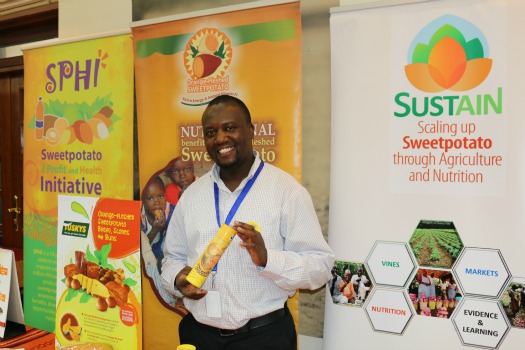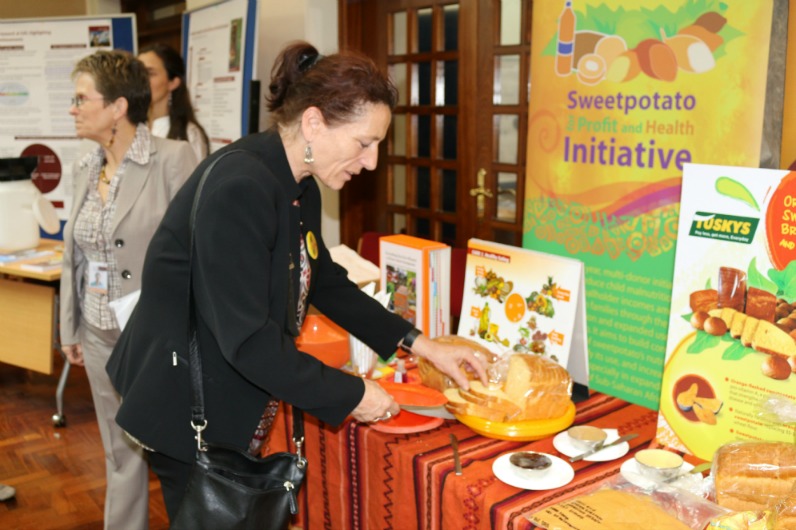
On 16 November 2015, a visit by a high level delegation from BMZ, visited ILRI, where Tawanda Muzhingi presented the progress that the International Potato Center (CIP) is doing to address bottlenecks in the sweetpotato value chain in Kenya and efforts to scale up the nutrition benefits of biofortified orange-fleshed sweetpotato (OFSP) with the goal is to reach 1.2 million households with under-5 year old children in Kenya, Malawi, Mozambique, and Rwanda by integrated interventions in agriculture, nutrition, utilization, and marketing to strengthen production and consumption of OFSP. The delegation which was made up of Ms. Christel Weller-Molongua (Division Head, GIZ, Agriculture and Rural Development), Ulrike Meier (Desk Officer, BMZ One World, No Hunger Initiative), Andrea Bahm (GIZ-Agriculture Programme Office), Julia Kronberg (Head of Cooperation and Development) and other embassy staff visited the ILRI campus to see first-hand the results of a collaborative engagement between the research institution and funding bodies in Germany. On hand to lead the delegation were Iain Wright, the Deputy Director General and Shirley Tarawali, the Assistant Director General of ILRI. After welcoming remarks and an introduction delivered by Tarawali, the visiting delegation was guided through a series of presentations. Muzhingi, is backstopping the development of orange-fleshed sweetpotato (OFSP) puree for industrial use as well as other OFSP product development in sub-Saharan Africa. He started his presentation by introducing the Sweetpotato for Profit and Health Initiative, which is led by the International Potato Center (CIP) and which seeks to reduce malnutrition and improve crop income among 10 million African households by 2020 through access to improved varieties of sweetpotato and their diversified use. The initiative is currently covering 17 countries. He outlined the role that the innovations in the use of sweetpotato puree for bakery products played in these efforts. Using the information and education materials on display, Muzhingi outlined the achievements made by CIP projects in increasing nutritional awareness, creating demand for OFSP products and training change agents through a ten day course for Trainers of Trainers on everything about sweetpotato. BMZ has invested significantly in sweetpotato activities in Kenya, by supporting projects that promote the production of sweetpotato flour as well as sweetpotato silage, which has been proven to increase both milk yields and milk production. It  is no wonder that CIP’s work elicited some discussion regarding the different products. Muzhingi explained that whereas sweetpotato flour was also a valuable product, CIP was pushing for increased puree production, because puree resulted in up to 50% wheat substitution, while flour only resulted in 20% substitution. This therefore, meant that puree would result in higher savings made from reduced wheat importation, which would free up much needed resources for improving social services such as education and healthcare. The end products made from puree would also have a higher concentration of vitamin A in the end products. The presentation at the CIP stand ended on a high note, as the guests of honor, led by Meier, tasted the freshly baked sweetpotato bread and received ‘I Love Sweetpotato’ badges from Muzhingi.
is no wonder that CIP’s work elicited some discussion regarding the different products. Muzhingi explained that whereas sweetpotato flour was also a valuable product, CIP was pushing for increased puree production, because puree resulted in up to 50% wheat substitution, while flour only resulted in 20% substitution. This therefore, meant that puree would result in higher savings made from reduced wheat importation, which would free up much needed resources for improving social services such as education and healthcare. The end products made from puree would also have a higher concentration of vitamin A in the end products. The presentation at the CIP stand ended on a high note, as the guests of honor, led by Meier, tasted the freshly baked sweetpotato bread and received ‘I Love Sweetpotato’ badges from Muzhingi.